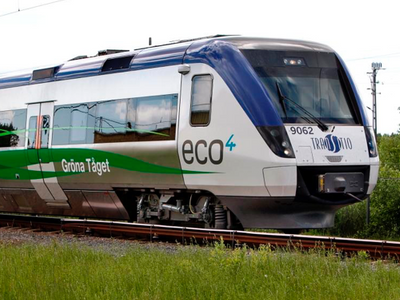Introduction to railway technology. Track technology. Rail vehicles - overview. The railway and the environment: energy consumption, air pollutions, external noise, external vibrations. Railway traffic development and future. Rail vehicles - technical basis. Aerodynamics and running resistance. Running gear, bogies and car body tilting. Traction technology: traction motors, transmission, traction mechanics and current collection. Braking technology. Car bodies. Passenger environment, interior design and auxiliary power. Internal noise, internal vibrations and climate resistance. Rail vehicle market and development.
SD2307 Rail Vehicle Technology 7.5 credits

Do you want to make an impact on the climate crisis? The transport sector accounts for more than 25% of the global energy consumption, and the most impactful action to reduce this is to shift passengers and goods to the modes of transport with highest capacity and energy efficiency; which, for most operations, is Railways.
Rail Vehicle Technology gives an extensive overview to rail vehicles and their technical basis, while you as a student design a commuter-type train in a course-long project task. The lectures and the project task advance in parallel throughout the course, in a weekly basis, so that technical aspects used in the design of the vehicle are available to the students throughout the lectures and online recordings.
Additionally, the course offers an optional study visit to the SJ Hagalund depot, so that you can see and feel in reality how different rail vehicles are, linking theory and simulations from the course to real life engineering practice.
Keywords (en): rail vehicles, vehicle, train, railway, component, design
Information per course offering
Choose semester and course offering to see current information and more about the course, such as course syllabus, study period, and application information.
Course syllabus as PDF
Please note: all information from the Course syllabus is available on this page in an accessible format.
Course syllabus SD2307 (Autumn 2010–)Content and learning outcomes
Course contents
Intended learning outcomes
The course gives a short introduction to railway systems and then focuses on rail vehicles.
The course aim is to give you the fundamentals of railway systems and, in particular, to describe the components and functions of rail vehicles as well as the various demands a rail vehicle must fulfil. The course should give you a good platform for work in the field of railway engineering.
After a completed course you should be able to:
- clarify the different parts in railway systems and their possibilities and limitations
- explain how bogies, carbody tilting, traction and brake systems work and can be improved
- calculate train performance like acceleration and braking capacity, average speed and energy consumption
- determine outer dimensions and interior design for a train at a given operational task
- discuss the trends and future potential for railway traffic
Literature and preparations
Specific prerequisites
150 university credits (hp) In engineering and documented proficiency in English corresponding to English B/ English 6.
Recommended prerequisites
150 university credits (hp) In engineering or natural sciences and documented proficiency in English corresponding to English B.
Equipment
Literature
Compendium on Rail Vehicle Technology, Div. of Rail Vehicles, KTH.
Examination and completion
If the course is discontinued, students may request to be examined during the following two academic years.
Grading scale
Examination
- PRO1 - Project Task, 3.0 credits, grading scale: P, F
- TEN1 - Examination, 4.5 credits, grading scale: P, F
Based on recommendation from KTH’s coordinator for disabilities, the examiner will decide how to adapt an examination for students with documented disability.
The examiner may apply another examination format when re-examining individual students.
The number of points achieved for TEN1 and PRO1 are summed. The final grade is based on this sum.Grading scale: A-F
Other requirements for final grade
Written Exam (TEN1; 4,5 hp; P/F), compulsory.
Project Task (PRO1; 3 hp; P/F), compulsory.
Opportunity to complete the requirements via supplementary examination
Opportunity to raise an approved grade via renewed examination
Examiner
Ethical approach
- All members of a group are responsible for the group's work.
- In any assessment, every student shall honestly disclose any help received and sources used.
- In an oral assessment, every student shall be able to present and answer questions about the entire assignment and solution.